4o
Have you ever wondered what all the fuss is about? Scotland. Why? Especially in winter must be far too cold and far too dangerous. Take a look – yes, it’s proper winter but isn’t that preferable to wet rain, umbrellas and grey days with little to differentiate between summer and winter, except for the lack of leaves on the trees.
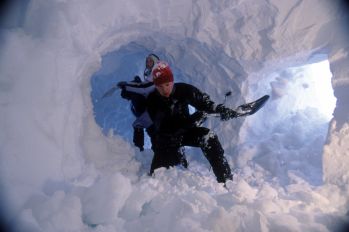
Photo Credit: Paul Tomkins/VisitScotland
Digging out a snow hole site in the Cairngorms under the guidance of Andy Bateman of Scot Mountain Holidays. It’s not quite Sweden’s ice hotel as you have to create the living space yourself, but they’ll have a relatively comfortable night out of the wind, cocooned in their sleeping bags enjoying being cooked for and served a three course meal by their guide.

Build your own snow hole in the Cairngorms
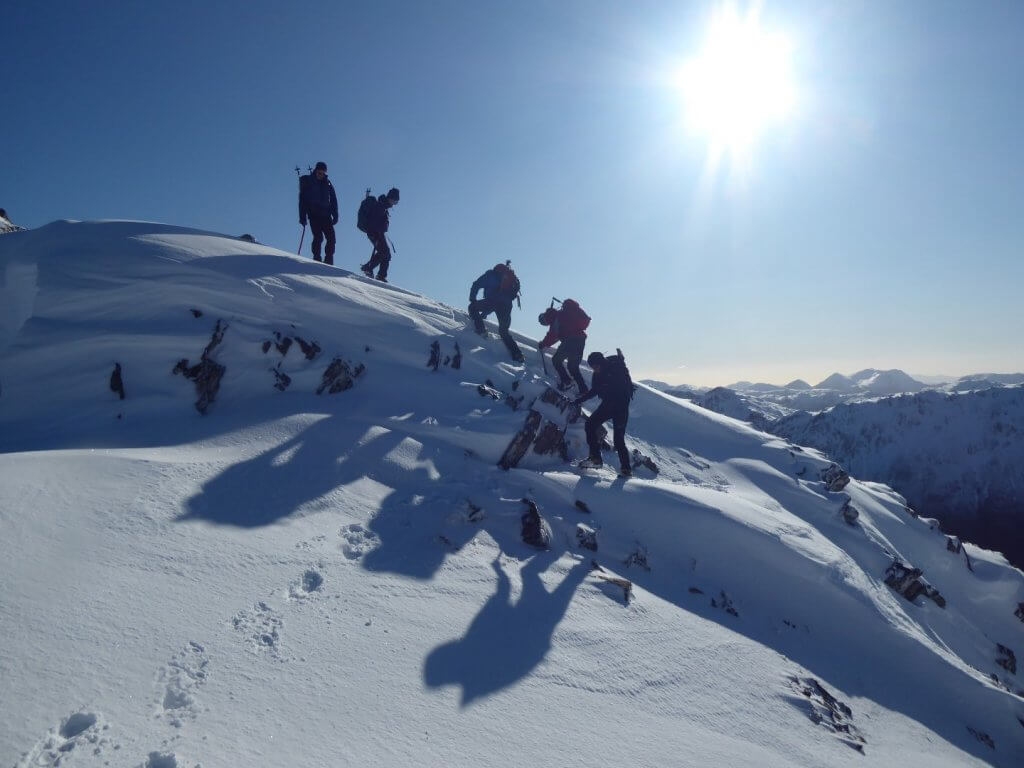
Hiking along the ridges of Argyll, Kintail or Glencoe – space to yourself away from all the crowds and views which stretch for miles under clear skies. We often visit the west coast of Scotland in March to bag some winter Munros: we’ve run trips in Argyll, Glencoe and Kintail. For this year’s offering check the calendar or the Munro bagging page. Some of our clients have left from these trips with the most spectacular images – but those are for another blog.
Photo credit: Dave Downing
The beauty of Glenmore in the winter. Snow laden trees and cross-country skiing opportunities. Short days are not always a disadvantage as they allow for the most spectacular photographic opportunities, as seen above.

Safety skills for walking in the winter hills, demonstrated here by Andy Bateman – ice axe arrest. Legitimate playing in the snow, but as part of a learning process on how to avoid a sliding fall.
Scotland on a cold, clear, crisp day in winter. What’s not to like, especially if you like to take stunning pictures.
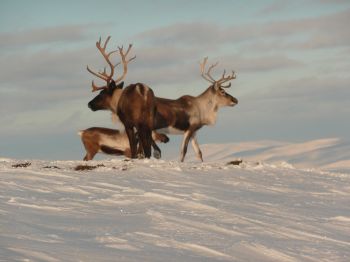
The Cairngorm Reindeer herd in their natural environment. When out walking in the Park, you can come face to face with the reindeer who roam the hills in winter.
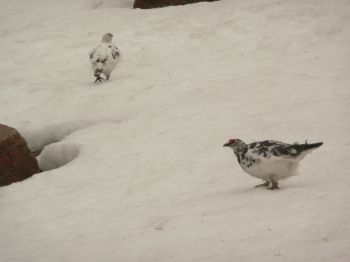
The Scottish Munros, particularly the Cairngorms, are the only area of the UK where you can spot Ptarmigan. Ptarmigan change their plummage twice a year – they have a summer coat, a breeding plummage and a winter coloration to blend in with the snow. You can almost step on the Ptarmigan sometimes as they like to conserve their energy by walking rather than flying if they can and they nest on the ground – there being no trees at the elevation where they are found.
a chance to savour some of Scotland’s most famous and unique produce. Haggis is a traditional meal to celebrate Scotland’s greatest bard, whose influence can be found everywhere from the Birks of Aberfeldy (where there is a thinking/writing seat dedicated to Rabbie Burns) to the Winking Owl in Aviemore, where the great bard is said to have taken breakfast. You might not even be aware of his influence on your own life from: “And we’ll tak a cup o’ kindness yet, for auld lang syne” – which you’ll have sung if you’ve ever brought the New Year in; to “O’ my luve’s like a red, red rose, that’s newly sprung in June” and a special Scottish grace for a meal: “Soem hae meat and canna eat And some would eat that want it. But we hae meat and we can eat, sae let the Lord be thankit.”
Burns Night is 25th January and is celebrated throughout Scotland with a haggis meal and the address to the haggis – written by Rabbie Burns.
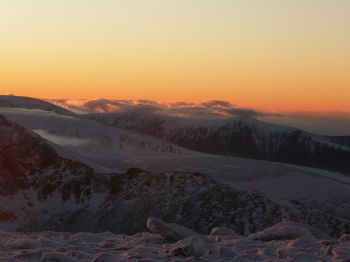
Scotland is famous for the colours of heather in the summer but the winter can be colourful too. This is the time of year that you’ll get to appreciate the sunset. The snow also reflects the light of the moon & stars if the sky is clear, so a night out in winter can be glorious.
snow will entertain the kids for hours and cost nothing, but make sure you’re well stocked with socks, gloves and hot chocolate!
Useful links:
Snow related activities for kids:
Free mountain weather service:
Met Office forecast for the hills:
Scottish Avalanche Information service:
In Scotland, there are plenty of walking tours. However, when you join Scot Mountain Holidays – it’s more than just a walk. It’s more of a complete adventure which will hopefully give you a sense of place and belonging. Not only do we feast on stunning mountain views, but we’re also treated to some spectacular, colourful and sometimes dainty looking wild flowers; and unexpected wildlife encounters.
Always bear in mind that September is also harvest month. In normal, times no doubt there would be church services to give thanks. Though we can’t do that this year, we have still been treated to some of the best of nature’s bounty (see images in slideshow).
This year we’ve picked loads of chanterelles and boletus mushrooms plus we’ve been able to find not 1 but 3 cauliflower fungi. It’s also a spectacular year for plums (from the garden) – and apples but they need a wee bit more time on the tree. Berries have been good too. Andy had brought back wild blueberries (blaeberries), wild cranberries (linganberries), juniper berries and cloudberries (highly prized in Scandinavia)
Though wildlife is not the focus of the walks Andy has led this month, he has some close encounters including 2 capercaillie and 2 black grouse down Glenfeshie. Unfortunately no pictures though to back up reports of the sightings.
Of course the dinners we’ve had this month have also been a highlight for everyone, but we’re usually too busy enjoying them to take pictures. We’ll try to add some in next month so you get a more complete picture of the trips and what makes them so special to the people who join us.
Here’s a sample from just this month of all the delights Andy has come across while out in the hills.
With thanks to Mala, Joanne, Valerie, David and Gareth for the excellent company this month.
using the sleeper service:
Sleeper discount available with Scot Mountain Holidays (see below for details)
There’s a lifetime of walking opportunities here in the Cairngorms National park, unfortunately most of us don’t have a lifetime to explore all those possibilities, and we have to squeeze in the chances to visit the Highlands into our busy lifestyles. The sleeper service from London to Aviemore makes the most of the limited time windows you might have. If you then combine the sleeper with an organised trip, you’ll not waste a minute.
Leave London after a full day’s work (train departs about 9pm) and wake up in the mountains. Then at the end of your trip, get in a full day’s walk/ride/challenge (and even have time to shower) before departing from the Highlands and waking up back in the Big Smoke ready for a full day at work.
Make even more of the limited time you have available by joining an organised group or booking a local guide. The guide/tour company will take on the responsibility for organising the logistics of your trip leaving you free to concentrate on the hiking.
Some tour companies (as opposed to individual guides) will offer fully inclusive packages where they organise the accommodation, the transport, the meals and the guiding, so all you have to do is pack your hiking gear and book your train ticket.
Try one of these organised hiking packages this autumn and spring:
Linking 2 of Scotland’s iconic themes – whisky and walking – this tour is a must for any active would-be whisky connoisseur. We’ll be walking in whisky country following the complete whisky story including a visit to the Speyside Cooperage (where the whisky barrels are formed), touring a distillery and finally going behind the scenes at the Whisky Castle in Tomintoul (an independent whisky shop, stocking unusual and one-off Scotch malt whiskies)
Full details and booking links here.
A challenging mountain adventure conquering all 5 of the Cairngorm peaks over 4000ft. Also attempted by Challenge Sophie (though her time was limited so they didn’t master all the peaks).
Full details and booking links here.
A weekend of high peak walking in the Cairngorms. We’ll head out to master Cairngorm and Ben Macdui, taking routes at the brink for the most amazing views and sunset colours (we hope).
Full details and booking links here.
Experience all the habitats of the Cairngorms from the ancient Caledonian pine forests at the foot of the mountain massif, rich in foraging opportunities and home to roe deer and the rare Capercaillie and crested tits; to the moorland where red grouse roam and finally explore the high mountain massif where if you’re lucky you’ll encounter reindeer and ptarmigan, who only live at altitudes above 800m.
Full details and booking links here.
Spring Watch and Autumn Watch are very well-known wildlife programmes on BBC television and always contain a focus on wildlife here in the Cairngorms National Park. 3 out of 5 of the Big Five (Golden Eagle, Red Deer and Red Squirrel) make their home here and for good measure you can also find ptarmigan, Capercaillie, crested tit and pine marten. All in all, if you’re keen on encountering the wild beasties in their natural habitats, you’ll love the hikes we’ve put together here.
Full details and booking links here.
If you do decide to take advantage of the less busy autumn period to head up to the Highlands, now you can take advantage of the special sleeper discount we have added to the above trips. (Not available over bank holiday weekends.)
Take the sleeper to Aviemore and back and save £60 per person!!
Imagine a place where you can trek through nature while indulging in fine whisky, handcrafted arts, local music and decadent home cooked meals. Autumn in the Cairngorms is a time to celebrate good food, colourful hiking and splendid photography opportunities as the sunrise and sunset become achievable times to be out and about.
A place where you can experience travel in Scotland at its finest. This is a place to discover breathtaking landscape from bagging Munros to relaxing on the beaches of Lochs Morlich, Insh and Tolmount. You will never run out of places to explore. There are activities for everyone from visiting castles and distilleries to hiking up the mountains or round the lochs. Autumn is also a time for the best mountain biking too.
But when is the best time of year to visit?
At Scot Mountain Holidays, nothing beats the vivid colours, crisp air, sunny days and cool evenings of autumn, a season of change.
Stags begin the rut, grouse take flight, and pheasant hunting season begins. Mountain ash, larch, silver birch, and sedges change colour and dazzle the landscape.
It is a time of wild mushrooms in risotto, pâtés, polenta slices and ragu. And don’t forget to top it off with the spicy taste of Cairngorm Brewery’s raisin ruby ale, Autumn Nuts!
Come soak in Autumn days and nights with us your hosts at Fraoch Lodge, where we provide everything you need for self-guided tours and home style hospitality, and be enchanted by a Highland fall.
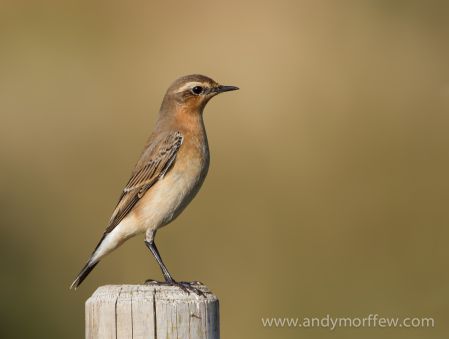
The Wheatear
Photo credit: Andy Morffew
If you go birdwatching near Aviemore, you’re bound to want to head up into the mountains. There are several species of bird you won’t find in your back garden which you’ll be on the lookout for. The Wheatear is probably one of them.
With the eyes on the ground and the mind on the conversation, the little Wheatear ahead of you flitting from one boulder to another can easily be missed. Take a closer look and it will reveal itself as a most striking little bird. A little bigger than a Robin, the most obvious feature of this bird is its white rump and tail. Its name has nothing to do with neither “wheat” nor “ears” but is a corruption of the words “White” and “Arse” by embarrassed Victorian’s. The male’s breast is of soft pastel tones of pink and bluff. The wings are black and its back sports a smart cape of grey. This is all topped of with a striking bandit like black eye stripe
It is one of the first to arrive in our mountains having completed a huge journey. The wheatear travels from sub Saharan Africa, across the Sahara, over the Atlas Mountains, the Mediterranean and up through Spain and France. It finally arrives in our mountains in April. On it’s migration it can cover up to 500 miles in a day. Not bad for a one ounce bird!! Some birds make a journey of 30 000km (18640 miles) – one of the longest migrating flights known.
They have one of the most extensive breeding ranges of any bird being found from Alaska to Iran. In Scotland they are often found on unimproved grassland between 300 and 800m up but have been found to be breeding on the highest ground in the Cairngorms at up to 1200m.
At one time in Sussex they were regarded as a delicacy and were trapped by shepherds for the restaurant tables of Lewes, Brighton and Eastbourne. Few birds now inhabit these parts due to loss of habitat but this is certainly not the case for the Scottish Highlands where the breeding population is estimated to be between 35 000 – 95 000 breeding pairs. They are one of our most common upland birds and one you are likely spot on your mountain journey.
Dotterel, Capercaillie, Crested Tit, Scottish Crossbill, Red and Black throated divers,
For details of private guiding for birdwatching opportunities try this page on our website.
If you would like to join a hiking group interested in wildlife watching opportunities try this itinerary in the Cairngorms National park.
All content © Copyright Scot Mountain Holidays 2025
Responsive web design by Summit Web Solutions